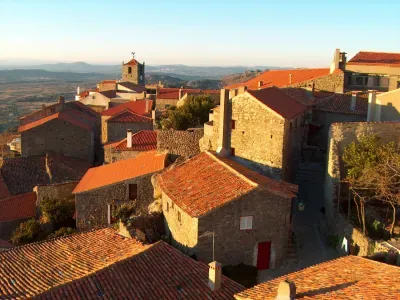
In 1938 Monsanto was voted the 'most Portuguese village in Portugal'. Since then it has been protected by building regulations that ensure the village retains an almost preternatural charm. Granite cottages are squeezed in amongst giant boulders, many of which form part of the houses themselves, as walls or steps, in a picturesque, higgledy-piggledy fashion. The tiny streets, just wide enough for a donkey, are carved out of rock and climb four hundred feet up a very steep hill. The hill, known as the Mons Sanctus, rises to a height of nearly eight hundred meters.

Evidence of human occupation dating back to Paleolithic times has been found, as well as remnants of Roman, Visigoth and Arabian occupation. King Afonso Henriques took Monsanto from the Moors in 1165 and granted it to the Templar monks, who built a fortified castle. The ruins of the castle can still be visited at the top of the hill, where views stretch as far as the Serra da Estrela and the Spanish border. Next to the castle are the ruins of a Roman chapel, with five stone tombs carved into the rock.
The plaza below the castle entrance is still used by dancers during festivals, the main one being the Festival of the Holy Cross (May 3rd) which commemorates the town's long history of sieges. Women climb the hill carrying rag dolls known as marafonas, while clay jars filled with flowers are thrown from the castle walls. Halfway to the castle is a gruta, a cavern once used as a drinking den (and still used as a drinking den, judging by the empty glasses lying around!).

The village itself, where elderly ladies still sit chatting on doorsteps watched by goats and chickens, is home to a couple of little town squares and the tiny, Romanesque, misericordia church. There is little in the way of public transport to Monsanto, which is twelve kilometers from Idanha-a-Nova, fifty kilometers from Castelo Branco and only a hundred miles from the Spanish town of Salamanca.
